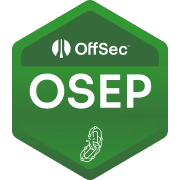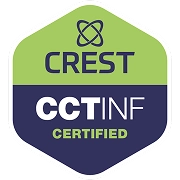
Certified Active Directory Pentesting eXpert
(C-ADPenX)
Certified Active Directory Penetration eXpert (C-ADPenX) is an expert-level exam designed to test a candidate’s expertise in identifying and exploiting vulnerabilities within Microsoft Active Directory (AD) environments. Candidates must demonstrate a deep understanding of AD concepts (both on-prem and Azure AD), attacks, and defenses to pass this challenging exam.
- Practical
- 7 Hours
- Online
- On-demand
- Real world pentesting scenarios
£400
Equivalent Industry Certifications*
*Note: We are not affiliated with any of the certifications mentioned here. These are respected industry certifications, and referenced here to show how our Certified Active Directory Pentesting eXpert (C-ADPenX) exam’s syllabus/difficulty overlaps with these exams.
If you already hold any of these, you’re likely well-prepared to test your knowledge with our exam. If you’re preparing for one, our exam is a great way to test your progress.
Our Candidates Say it Best
Who should take this exam?
C-ADPenX is intended to be taken by penetration testers, red team members, blue team members, security engineers, and AD administrators who want to validate their expertise in Active Directory security. It is also ideal for anyone seeking to elevate their skills in securing or attacking AD infrastructures.
What is the format of the exam?
C-ADPenX is a rigorous 7-hour practical exam that challenges candidates to identify and exploit real-world vulnerabilities within a simulated AD environment. Candidates will need to:
- Perform reconnaissance to map and understand the AD infrastructure.
- Obtain an initial foothold within different AD forests.
- Exploit misconfigurations to escalate privileges and gain control over multi-domain environments.
- Demonstrate techniques for persistence, lateral movement, and advanced AD compromises.
The exam can be taken online, anytime (on-demand), and from anywhere. Candidates will need to connect to a dedicated exam VPN server to access the pre-configured AD infrastructure.
What is the pass criteria for the exam?
The pass criteria are as follows:
- Candidates scoring over 60% marks will be deemed to have successfully passed the exam.
- Candidates scoring over 75% marks will be deemed to have passed with merit.
What is the experience needed to take the exam?
This is an expert-level exam, and candidates should possess extensive hands-on experience with Active Directory pentesting. Prior knowledge of AD exploitation techniques, Windows security, and privilege escalation is required.
Note: As this is an expert-level exam, a minimum of five years of professional pentesting or red teaming experience is recommended.
What will the candidates get?
Upon successful completion of the exam, candidates will receive:
- A certificate indicating their pass/fail and merit status.
- A unique certificate code/QR link for validation purposes.
What is the exam retake policy?
Candidates who fail the exam, are allowed one free retake within the exam fee.
What are the benefits of this exam?
The exam will allow candidates to demonstrate their understanding of securing and attacking Active Directory environments. This will help them to advance in their career.
How long is the certificate valid?
The certificate does not have an expiration date. However, it will include the exam version and the date it was taken. Candidates are encouraged to retake updated versions of the exam as it evolves to reflect new attack methods and defenses.
Will you provide any training that can be taken before the exam?
Being an independent certifying authority, we do not provide any training for the exam. Candidates should carefully go over each topic listed in the syllabus and make sure they have adequate understanding, required experience, and practical knowledge of these topics. Further, the following independent resources can be utilized to prepare for the exams.
Learning Resources
Exam Syllabus
Active Directory Reconnaissance
- Mapping domain environments, forests, and trusts.
- Enumerating users, groups, and system details through various techniques.
Credential Harvesting and Attacks
- Capturing and cracking password hashes.
- Exploiting authentication mechanisms using Kerberoasting, AS-REP Roasting, and password spraying.
- Identifying and attacking weak authentication configurations.
Privilege Escalation
- Identifying and exploiting misconfigured AD objects.
- Leveraging vulnerabilities in Group Policy Objects (GPOs) and Active Directory Certificate Services (ADCS).
- Abusing tokens, user privileges, and nested group memberships.
Persistence Techniques
- Implementing advanced persistence mechanisms in Active Directory environments.
- Exploiting service accounts, delegated permissions, and other long-term footholds.
Lateral Movement
- Moving between systems using techniques like Pass-the-Ticket and Pass-the-Hash.
- Exploiting trust relationships across multi-domain environments.
Lateral Movement
- Moving between systems using techniques like Pass-the-Ticket and Pass-the-Hash.
- Exploiting trust relationships across multi-domain environments.
Domain and Forest Compromise
- Gaining control over domain controllers (DCs) and achieving domain dominance.
- Extracting and analyzing NTDS databases offline.
- Manipulating AD configurations to achieve full forest compromise.
Azure Active Directory Exploitation
- Attacking hybrid environments with Azure AD Connect.
- Exploiting vulnerabilities in synchronization processes and privileged accounts.
Advanced Techniques for Defense Evasion
- Bypassing modern security controls, including antivirus and endpoint detection and response (EDR).
- Using obfuscation techniques to maintain stealth during operations.
Data Extraction and Exfiltration
- Identifying and extracting sensitive data from compromised environments.
- Safely handling and securing critical information post-compromise.
Automated Vulnerability Scanning and CVE Exploitation
- Utilizing automated tools to identify and assess vulnerabilities in AD environments.
- Exploiting known Common Vulnerabilities and Exposures (CVEs) to escalate privileges and gain unauthorized access.
- Understanding patch management and mitigation strategies from an attacker’s perspective.
Bypassing Security Controls and Advanced Persistence
- Evading security monitoring tools such as SIEM, EDR, and intrusion detection systems.
- Leveraging golden ticket, silver ticket, and skeleton key attacks for long-term persistence.
- Modifying AD security policies to maintain hidden access and persistence.




